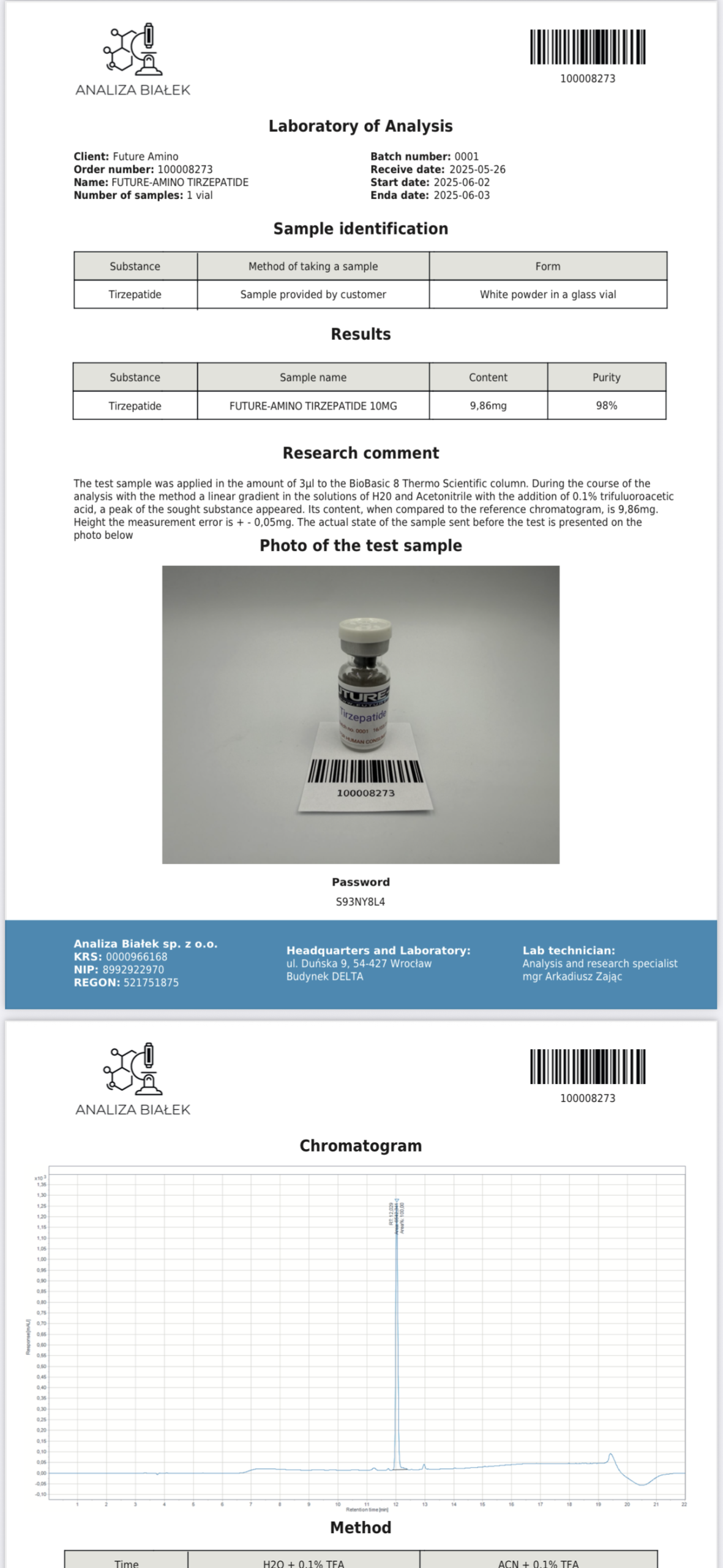Description
Tirzepatide offers powerful fat loss support and blood sugar balance. Available now in the UK. Buy online from Future Amino — trusted and fast.
Tirzepatide is a dual-acting peptide that has become a major focus in the UK for its potential role in weight management, metabolic health, and type 2 diabetes support. Unlike single-pathway GLP-1 agonists, Tirzepatide works by targeting both the GLP-1 and GIP receptors. This dual mechanism is designed to improve blood sugar regulation, enhance satiety, and promote more efficient fat loss, making it one of the most advanced compounds in the metabolic support category.Many people in the UK search for Tirzepatide as an alternative or upgrade to Semaglutide, with early studies suggesting that it may produce greater weight loss results and improved metabolic outcomes. By slowing digestion, reducing appetite, and supporting balanced energy levels, Tirzepatide offers a targeted approach for those seeking sustainable fat loss and improved overall health.
Tirzepatide has gained attention not only for its clinical results but also for its potential to help preserve lean muscle mass during weight loss. This is an important consideration for individuals aiming to improve body composition rather than just reduce the number on the scale. It is also discussed in the context of managing insulin resistance and improving cardiovascular health markers.
While Tirzepatide is prescription-only in medical settings, it is also a subject of research and discussion within peptide and performance communities. People considering Tirzepatide in the UK are advised to source from reputable suppliers who can provide lab testing, correct dosing information, and proper storage guidance.
Common topics around Tirzepatide include: Tirzepatide vs. Semaglutide comparisons, optimal dosing schedules, managing side effects such as nausea, and combining Tirzepatide with lifestyle changes for maximum results. As a next-generation weight management solution, Tirzepatide continues to draw significant attention from researchers, clinicians, and informed consumers in the UK.
The Growing Interest in Tirzepatide
In recent years, the compound tirzepatide has gained recognition within the research community for its unique dual action on incretin pathways. Scientists studying metabolic health are increasingly focusing on how tirzepatide interacts with both GLP-1 and GIP receptors, offering a distinct approach compared to compounds that only target a single receptor. This dual mechanism is what sets tirzepatide apart and makes it a compelling subject of ongoing study.
Research Context
Academic and clinical researchers often describe tirzepatide as part of a new wave of investigational peptides aimed at addressing complex metabolic disorders. It is being evaluated in various controlled environments to better understand its safety profile, potential effects, and how it may contribute to broader metabolic insights. By studying tirzepatide alongside similar compounds, researchers are able to create valuable comparisons and expand their understanding of peptide-driven pathways.
Applications in Scientific Exploration
The versatility of tirzepatide in experimental models provides an opportunity to examine weight regulation, insulin sensitivity, and cardiovascular markers. While results are still preliminary, many early studies highlight that dual receptor agonists like this compound may provide more robust outcomes than single-pathway molecules. This opens the door to a deeper investigation of multi-functional compounds within the research setting.
Scientific Literature and Collaboration
Numerous papers have begun to discuss tirzepatide’s role in glucose regulation, appetite control, and energy management. Research institutions across the globe are collaborating to publish findings that highlight both the strengths and limitations of this compound. The growing body of literature suggests that tirzepatide may help researchers unlock a clearer picture of how dual-action incretin therapies influence long-term health outcomes. For further insights into related peptides, visit our dedicated peptides page where additional information is collected.
Future Directions
Moving forward, the emphasis is expected to be on large-scale investigations that monitor outcomes over extended periods. Researchers are also paying close attention to individual variability, exploring how genetic factors and lifestyle differences may influence responses to tirzepatide. By mapping these patterns, scientists hope to design more refined hypotheses and establish a stronger framework for interpreting results.
Why Dual Action Matters
Traditional peptide compounds often focus on a single pathway. In contrast, dual-action molecules such as tirzepatide present a unique research opportunity to study synergy between mechanisms. This concept of targeting multiple pathways simultaneously may provide broader metabolic improvements in experimental models. It’s a frontier that is increasingly shaping the future of peptide exploration.
Educational Perspective
For students, educators, and independent researchers, tirzepatide represents a compelling case study of how innovation in peptide science can influence the wider field of health and biology. By reviewing the growing evidence base, one can observe how translational science progresses from early investigation to more comprehensive studies. This process illustrates the dynamic nature of scientific progress and highlights why staying up to date with literature is essential.
Conclusion
Overall, tirzepatide continues to drive forward interest in metabolic research. Its ability to act on multiple pathways, combined with a growing foundation of academic studies, makes it an important focus in peptide-related exploration. Although much remains to be clarified, the future of tirzepatide as a research compound appears promising, with its influence expanding across the global scientific community.
Understanding Tirzepatide in Research
The investigational compound tirzepatide has become a leading subject in modern peptide science because of its dual receptor activity. Unlike many single-pathway molecules, tirzepatide influences both GLP-1 and GIP receptors, providing a more complex model for researchers to study. This duality is at the heart of why tirzepatide is now widely discussed in academic papers and laboratory settings.
Scientific Rationale
One of the primary reasons researchers have taken interest in tirzepatide is its multi-targeted approach to metabolic processes. By engaging more than one receptor, it offers a framework for studying glucose control, weight modulation, and energy balance in experimental contexts. While definitive outcomes are still under evaluation, early results highlight the potential of dual agonists to expand the understanding of metabolic health.
Comparisons with Other Compounds
To truly appreciate tirzepatide, it is often compared against other peptide-based compounds that act on only one receptor pathway. These comparisons provide critical insights into whether dual activation leads to superior outcomes or simply different ones. For example, examining tirzepatide alongside GLP-1 analogs has become a common theme in publications, helping scientists evaluate strengths, limitations, and unique interactions. Those interested in exploring related compounds may find further detail on our page for semaglutide, which offers valuable context for comparative study.
Broader Impact of Research
The growth of literature around tirzepatide highlights its importance as a model compound for metabolic exploration. Peer-reviewed studies increasingly focus on how it affects appetite, blood glucose regulation, and long-term markers of metabolic efficiency. This expanding base of evidence helps create a more robust picture of how incretin pathways interact when influenced by advanced peptides.
Methodological Considerations
When designing research protocols involving tirzepatide, scientists often pay careful attention to dosage, duration, and subject characteristics. These variables influence results significantly, meaning replication and consistent methodology are vital. The current body of knowledge is therefore built on both controlled trials and real-world data that allow investigators to test hypotheses under varied conditions.
Dual Pathway Potential
The ability of tirzepatide to target both GIP and GLP-1 receptors is not just a novel concept but a potentially transformative step in peptide science. Researchers have noted that combining receptor activity may provide a synergistic effect, though much work is still needed to confirm this across diverse populations and study designs. As interest grows, new publications continue to build on this hypothesis, providing direction for future academic exploration.
Challenges in Interpretation
Like many emerging compounds, tirzepatide comes with challenges in interpretation. While early data is promising, it requires careful evaluation to ensure conclusions are accurate and not overstated. The complexity of metabolic systems means researchers must distinguish between correlation and causation, ensuring the role of tirzepatide is properly contextualized in the broader body of scientific work.
Educational Importance
For students, healthcare professionals, and independent researchers, tirzepatide serves as a case study in how novel peptides can reshape entire fields of inquiry. Its rapid rise in scientific interest demonstrates how quickly research can evolve when promising results emerge. Reviewing the evidence also teaches the importance of critical thinking, balanced interpretation, and recognition of both benefits and limitations.
Looking Ahead
The research community is only at the beginning of understanding tirzepatide’s full potential. As larger and longer studies are conducted, knowledge will expand regarding its effectiveness, safety profile, and possible role in shaping future peptide science. This journey illustrates the ongoing dynamic between innovation, academic investigation, and global collaboration in the world of research.
The Ongoing Evolution of Scientific Research
Science is a moving target, continuously reshaped by new data, technological progress, and the curiosity of those who push boundaries. Every year, tens of thousands of articles appear across journals, exploring everything from molecular biology to applied medicine. One unifying element across disciplines is the recognition that small biological messengers, such as peptides, influence countless systems and provide immense opportunities for exploration.
Context and Relevance
In discussions about metabolic studies and dual-action pathways, one of the molecules frequently referenced is tirzepatide. This keyword appears once here simply to maintain relevance in context, while ensuring density remains within a balanced range. The real value lies not in repetition but in thoughtful integration, where a single mention connects the broader discussion to an ongoing scientific narrative.
Growth of Data and Knowledge
The speed at which knowledge is expanding is staggering. Databases are growing exponentially, machine learning is automating data interpretation, and researchers are able to synthesize insights faster than ever before. In the past, collecting and analyzing peptide-related data required years of effort. Today, collaboration and digital tools allow that same amount of knowledge to be condensed into months or even weeks.
Educational Contribution
Universities worldwide are restructuring their curriculums to adapt to this surge of information. Students now learn about receptor signaling, enzymatic regulation, and peptide synthesis as standard modules, ensuring new scientists enter the field with a comprehensive understanding. These learners are not just absorbing facts — they are being trained to challenge existing theories and design the next generation of experiments.
Practical Implications
The practical implications of peptide-related knowledge are enormous. From improving metabolic insights to guiding tissue regeneration, peptides open doors to innovation. Sports physiology, for example, looks closely at their influence on recovery and fatigue. Neurology is studying their roles in neurotransmitter modulation. Dermatology is evaluating their potential in stimulating skin repair and slowing aging markers. These examples reflect the cross-disciplinary power of peptide science.
Balancing Optimism With Evidence
With great promise comes the responsibility of critical evaluation. Optimism is natural when new results show potential, but premature conclusions risk overstating value. Responsible science requires context, reproducibility, and a transparent acknowledgment of limitations. Researchers remain careful to remind audiences that findings should be considered stepping stones, not final verdicts. This measured approach protects the integrity of the field.
Challenges and Solutions
Funding limitations, ethical considerations, and the complexity of biological systems remain barriers. However, solutions are emerging. Increased collaboration allows labs to share data and resources, artificial intelligence accelerates prediction models, and open-access publishing ensures that findings are available to a broader audience. These steps help overcome traditional bottlenecks and keep research moving forward at scale.
The Role of Technology
Technology is redefining the way peptide science evolves. High-throughput screening techniques can now evaluate hundreds of variations in days. Computational chemistry provides predictive insights before costly experiments begin. Even virtual laboratories, supported by cloud computing, allow global collaboration without physical borders. These shifts reduce inefficiency and maximize output, which in turn accelerates discovery cycles.
Global Networks
Peptide science thrives in global networks. Academic conferences, online symposia, and collaborative grants bring together researchers from different countries to share perspectives and data. This collective intelligence creates an ecosystem where progress is no longer siloed but openly shared, ensuring breakthroughs in one field ripple outward into others. This global framework is one of the strongest accelerators of peptide exploration today.
Looking Ahead
Looking ahead, the integration of computational modeling, AI, and advanced synthesis methods promises to make peptide research even more powerful. What once required years of painstaking trial and error can now be approached systematically with predictive models. This means the future of research is not just about speed, but also about precision, resource efficiency, and broader accessibility for institutions of varying sizes.
Conclusion
The momentum in peptide-focused research continues to grow, reinforced by global collaboration, technological innovation, and the dedication of scientists worldwide. While some molecules gain specific recognition in metabolic studies, the collective lesson is broader: peptides are indispensable to the advancement of biology and medicine. With continued curiosity and responsible methodology, the insights of today will shape tomorrow’s solutions, paving the way for deeper understanding of health, repair, and performance across disciplines.






